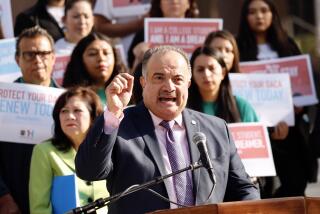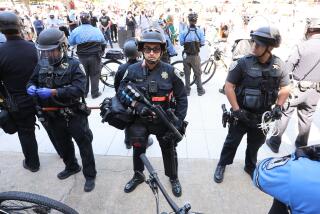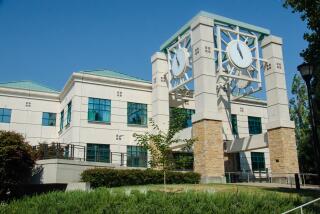Head of Nuclear Research Lab Resigns Under Fire : Science: John H. Nuckolls was under increasing pressure to leave Lawrence Livermore because of alleged mismanagement. The action comes at a time of major restructuring at the University of California facility.
The director of Lawrence Livermore National Laboratory, one of the governmentâs premier nuclear weapons research centers, resigned Monday--just days before University of California President Jack W. Peltason was prepared to call for his termination because of mismanagement at the billion-dollar lab.
John H. Nuckolls, 63, has come under increasing pressure from Peltason to step down from the $195,500-a-year post since February, when an internal review panel found âserious management shortcomingsâ during Nuckollsâ tenure over the last five years.
Nuckolls was supported by prominent physicist Edward Teller, the father of the hydrogen bomb, and appeared to be rallying some support among UC regents, who are responsible for overseeing Lawrence Livermore and two other university labs, sources said.
But in a March 30 letter to Nuckolls labeled âpersonal and in strict confidence,â Peltason cited Nuckollâs âfailure to accept my repeated requests that you resignâ and served notice that he would ask the regents Wednesday to fire him for âsignificant deficiencies in your management abilities.â Neither Nuckolls nor Peltason could be reached for comment late Monday but both men released statements announcing the resignation. Peltason said he will recommend a temporary replacement Wednesday for Nuckolls, who is stepping down May 1 âfor personal reasonsâ but will continue as an associate director at large.
In a post-Cold War era of ârevolutionary change, I believe the laboratory will benefit greatly by the new thinking and new vitality provided by a new director,â Nuckolls said.
Nuckollsâ resignation comes at a key time for the lab, which has a budget of slightly more than $1 billion. With the ending of the Cold War, the federal government has dramatically scaled down funding for nuclear weapons research and the university has been scrambling to redirect its scientists into joint ventures with private companies.
Since Nuckolls took over the lab in 1988, the number of joint ventures with companies ranging from IBM and General Motors to start-up biotech firms has grown from none to more than 100, said lab spokesman Jeff Garberson.
But Nuckolls has been criticized by some for being too much of a cold warrior. Last month, the lab director appeared before a panel of the House Armed Services Committee in Washington to warn about the dangers of nuclear proliferation and the need to keep nuclear defense skills high, and to argue that the withdrawal of government funding for weapons research be reversed, Garberson said.
He has also fought against a proposal in Congress to consolidate nuclear weapons research, a move that would shift those functions from Livermore to UCâs lab at Los Alamos, N.M., where the atom bomb was developed, said Hugh DeWitt, a staff physicist at Livermore for 37 years and a critic of Nuckolls.
âIt marks him as a director from the Cold War era,â DeWitt said.
When Nuckolls took over the Bay Area laboratory five years ago, about $315 million of the annual $896 million in federal funding was spent on weapons research. Today, that amount has dwindled to $198 million out of $705 million. The lab has 7,400 full-time positions for scientific research, including the civilian fields of biotechnology, energy science and laser use.
Nuckolls joined Livermore in 1955, three years after the lab was founded, and worked in the labâs A Division, which designs thermonuclear bombs. He led research into âStar Warsâ concepts, such as missile-destroying lasers, and worked on âinertial confinement fusion,â which attempts to create a miniature type of hydrogen bomb by using lasers to explode pellets of hydrogen isotopes.
But it was his management skills that brought about the confrontation with Peltason. Even by scientists who support his views on nuclear weapons and proliferation, Nuckolls was seen as an âindecisive managerâ who âlets things slide,â DeWitt said.
As an example, DeWitt said Nuckolls left a key position in the physics department unfilled for five months, prompting the department to begin âdriftingâ and causing a drop-off in fundamental research.
His management became the issue after a seven-member panel appointed by Peltason last fall conducted a review of how Nuckolls was running the lab. A UC spokesman said the panel interviewed more than 70 people--34 lab employees who submitted written statements and the rest high-level U.S. Department of Energy or Pentagon officials.
Although universally known to have been negative, the reviewâs specific findings have not been released. But in a letter to Peltason dated March 28, Nuckolls said the panel spent only two days at the lab and based its conclusions on âerroneous information.â
He wrote that officials from the labâs principal âcustomersâ--the Pentagon and Department of Energyâs defense programs--wanted him to continue for national security reasons. He also raised the question of political retribution because the review panel was chaired by Richard Truly, a former National Aeronautics and Space Administration administrator who was dismissed after reportedly being criticized by Teller and others.
University sources said Teller was involved in lobbying regents in Nuckollsâ behalf this week but that the showdown was averted by the directorâs resignation.
More to Read
Sign up for Essential California
The most important California stories and recommendations in your inbox every morning.
You may occasionally receive promotional content from the Los Angeles Times.










